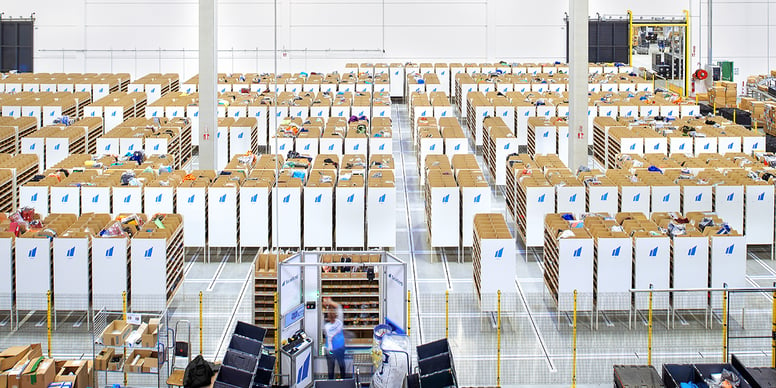Supply chain management is a key factor in your company’s prosperity, expansion and ability to remain competitive.
Read on to find out everything you need to know about supply chain management, how to optimize it, and how to foresee future changes.
Logistics management: definition and introduction
Gestion logistique : définition et présentation
Logistics covers all activities and processes required between the initial request for a product and its final reception by a customer. It therefore involves administrative, organizational and management-related aspects.
SCM (Supply Chain Management) designates the set of tools, resources and techniques used to manage a supply chain as efficiently as possible. Supply chain management can be divided into three stages: scheduling, restocking, and closure of orders once the customer is satisfied.
Each of these steps contains numerous smaller steps, all serving a single purpose: to make the right product available at the right time, as rapidly as possible and with the best possible quality.
Logistics and supply chain management are strategically important, therefore, and can cover numerous areas, including:
- Organizing the restocking of raw materials;
- Ensuring consistency between restocking requirements and production;
- Management of suppliers and carriers;
- Stock and storage control;
- Workflow management supervision;
- Order picking;
- Freight chartering;
- Optimization of distribution routes;
- Returns management etc.
Logistics directly impacts a company's bottom line and its revenue, so it's essential to track performance and optimize each process.
Logistics management: which KPIs?
To measure the efficiency of your supply chain, the key metric is OTD (on time delivery).
OTD allows you to determine the global efficiency of your supply chain by comparing, over a given period, the number of orders delivered on time against the number of orders placed. The higher your OTD rate, efficient your organization.
Other KPIs highlight the various strengths and weaknesses of your supply chain, including:
- Order preparation rate;
- Stockout rate;
- Accuracy of order picking;
- Completed orders shipped;
- Backorders ;
- Order fill rate;
- Orders shipped on time;
- Cycle time of internal orders;
- Availability rate;
- Average cost per product;
- Vehicle fill ratio;
- Orders prepared on time and ready to ship etc.
How to optimize logistics management
To optimize logistics management, KPIs obviously have to be tracked and analysed to identify all possible areas for improvement. But there are other ways to optimize your supply chain:
1. Create a detailed map of your supply chain
This will allow you to link your logistics strategy to the management of your supply chain. By identifying each of the cogs in the greater mechanism you’ll have a clear vision of where you need to optimize.
2. Raise awareness, inform, train and encourage your logistics teams
Your employees provide valuable support in driving change. By involving them in changes and informing them of the benefits for them and the company, they’ll be more inclined to accept change and will in turn encourage other employees to do the same.

3. Save time in your logistics processes
Introduce cross docking to reduce the movement of products and increase the productivity of your employees, or deploy a Warehouse Management System (WMS) for tracking and tracing products in stock and orders in transit.
Supply chain management: what’s the future looking like?
The global outbreak of Covid-19 in 2020 was a severe shock for e-commerce. Faced with the health crisis, companies had to take quick measures to adapt (changes in return policy, employee protection etc.).
Supply chain management was directly impacted. While many emergency measures were introduced, this health crisis of unprecedented magnitude also provided us with some important lessons for the future of logistics management.
Many tools - some already widely used, others whose potential remains to be explored and deployed - offer a way to respond to such a situation.
What’s the future of logistics management?
Logistics management looks set to undergo many changes in the coming years. Look out for the following emerging trends:
- More eco-responsibility and a fairer labour policy that respects environmental standards: driven by globalization and new technologies, the demand for transparency is growing. Social and environmental issues are becoming increasingly important, so the supply chain must lead by example;
- Improved reliability, with secure supply chain processes to ensure a continuous flow of orders, and taking into account all human and technological action likely to impact the chain;
- Real-time, transparent track and trace of products, from their manufacture to their arrival at the final recipient;
- A scalable/agile supply chain capable of adapting in real time to fluctuations in needs, demands and changes over short periods of time;
- More transparency and suppleness, with a supply chain capable of responding to the hyper-personalization of products and offers, with customization possible right up to the very last link in the chain, just before final shipment to the end customer;
- Increasingly connected vehicle fleets: new technology, and IoT in particular, is revolutionizing logistics and transportation. Real-time connectivity will allow more accurate calculation of the number of transportation hops and drivers needed at any given time to meet demand;
- Innovations that offer customers an integrated experience, regardless of the channel, linked to real-time track and trace of goods via RFID technology;
- Computer-Aided Maintenance Management (CAMM) software that provides real-time tracking to make the right decisions at the right time and at the right cost.
- Supply chain management systems that communicate directly with suppliers: this will allow real-time monitoring of every price change in the tariffs of the different suppliers, while accelerating the transfer of information and money, for an ever faster service;
- More efficient, more transparent supply chain management: by automating processes and improving communication, it takes fewer steps and resources to satisfy our customers. At the same time, more transparency is essential: consumers are increasingly sensitive to how their data is used, the sustainability of goods, and their origin;
- Deployment of artificial intelligence and automation/robotics to optimize and accelerate processes and reduce errors;
- The use of connected objects to anticipate potential disruptions and automatically implement the appropriate responses.
These coming changes will pose real challenges, but they will also signify real advances for businesses, their employees, consumers, and the planet. All of these emerging trends and technologies will make it possible to offer an ever-faster and more efficient service while better serving everybody’s needs.

Logistics automation and robotics
Precipitated by the Covid-19 crisis, the changes that will occur over the next few years are a step in the right direction. While many of the technologies needed to effect these changes have yet to be developed or made available to the wider market, others already exist and are making a difference.
One technology that’s available right now and helps you rise to the challenges facing today’s logistics sector - a comprehensive robotics and software package to automate your logistics platform with gains in:
- Adaptability: robots can easily adapt to the requirements of enterprises and changing business patterns;
- Responsiveness: software enables real-time monitoring of your warehouse, which means you can make the right decisions when it matters;
- Reliability: Secure picking makes operators’ work easier, improves their productivity, and reduces errors;
- Agility: Shelf units can be quickly installed and removed to respond to changing needs and optimize storage area. These innovative storage units deploy with no disruption to the work of operators or logistic flows.
Artificial intelligence, robotics and process automation are going to revolutionize the supply chain. To meet new and emerging logistics needs, adaptation is the key. That is why it's essential to opt for a scalable solution that’s capable of adapting to your requirements, with reliable real-time supervision.
Such a solution lets you optimize management of your supply chain and get ready for the changes that will take place in the coming years, in your enterprise and all over the world. More than a challenge, it's an investment in the future.




Laisser nous votre commentaire